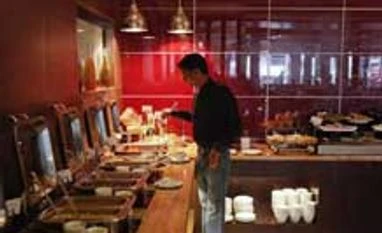So, alongside the pricey $130 Florentine-style T-bone steak (for two) the menu features dishes such as a cauliflower flan with porcini and avocado panzanella, buffalo mozzarella fondue, and black truffle shavings, at a more affordable Rs 1,250.
The branch of New York's venerable Le Cirque, at the Leela Mumbai hotel, is the latest in a wave of overseas-based high-end eateries to enter a country that has been slow to embrace the global-restaurant trend that has taken hold in cities like Dubai and Hong Kong.
Top-end restaurants are targeting India's growing affluent classes. Indian household wealth nearly doubled to $2 trillion in five years through 2012, according to Boston Consulting Group, which expects that to grow to $4.5 trillion in 2017. Millionaire households totalled 164,000 last year.
Other global chains in India include London-based Chinese-themed Hakkasan, which opened in 2011, and its less-expensive sister Yauatcha, a hit in Mumbai that will soon open its fourth Indian location. Last year, Spain's Arola opened at the JW Marriott in suburban Mumbai.
Top flight international chains in India face the challenge of matching the standards of the original while adapting to preferences in a country where many people are vegetarians and most don't eat beef for religious reasons. Most ingredients are imported, which pushes up costs and prices.
Indian consumers, meanwhile, have proven reluctant to splash out on branded luxuries, such as designer labels, said Vir Sanghvi, a journalist and food writer. "So far, India has been immune to the culture of the global restaurant, because India is a price-sensitive market," he said.
More From This Section
NASCENT FOODIE CULTURE
While foodie culture of the sort that is rampant in many places is in its infancy in India, operators of fancy restaurants hope to build their niche as incomes grow and more Indians who travel develop a taste for high-end dining. About 6-8 percent of guests at Le Cirque in New York are from India.
"It feels a little pioneering to us," Mario Maccioni, whose father Sirio opened the original Le Cirque in 1974, said over a pre-opening dinner at the Mumbai restaurant.
High-end chains in India and other emerging markets tend to be in hotels, which operate them as franchises and bear much of the cost but have an in-built customer base and use the brands as a draw for other hotel business.
Given a poor track record for French restaurants in India, often perceived to be meat-heavy and for special occasions, the local Le Cirque menus play up the Italian side of the chain's French-Italian offerings.
"French restaurants have struggled. We didn't want to be put in that category," said Rajiv Kaul, president of The Leela Palaces, Hotels and Resorts, part of Hotel Leelaventure Ltd , which in February will open a Le Cirque Signature in Bangalore.
At the Le Cirque in New Delhi's Leela Palace Hotel, which opened in 2011, the average check is 5,000 to 6,000 rupees per person, putting it among India's most expensive restaurants. It generates nearly 10 million rupees a month, Kaul said.
Another import at the New Delhi hotel, New York-based Japanese chain Megu, does nearly as much business but at lower margins because almost every ingredient is imported, he said.
Kaul expects spending per person at Le Cirque Signature in Mumbai, which is smaller and less formal than the New Delhi restaurant, to be about 20 percent lower than in New Delhi, where customers tend to buy more expensive wine.
For Boglione, a 38-year-old native of Florence, Italy, adapting to India means cooking more vegetarian items than he was accustomed to and planning further ahead to source hard-to-find ingredients. He recently found purveyors of porcini mushrooms and yellow beetroot.
"With vegetables, you can do nice stuff," he says.
)